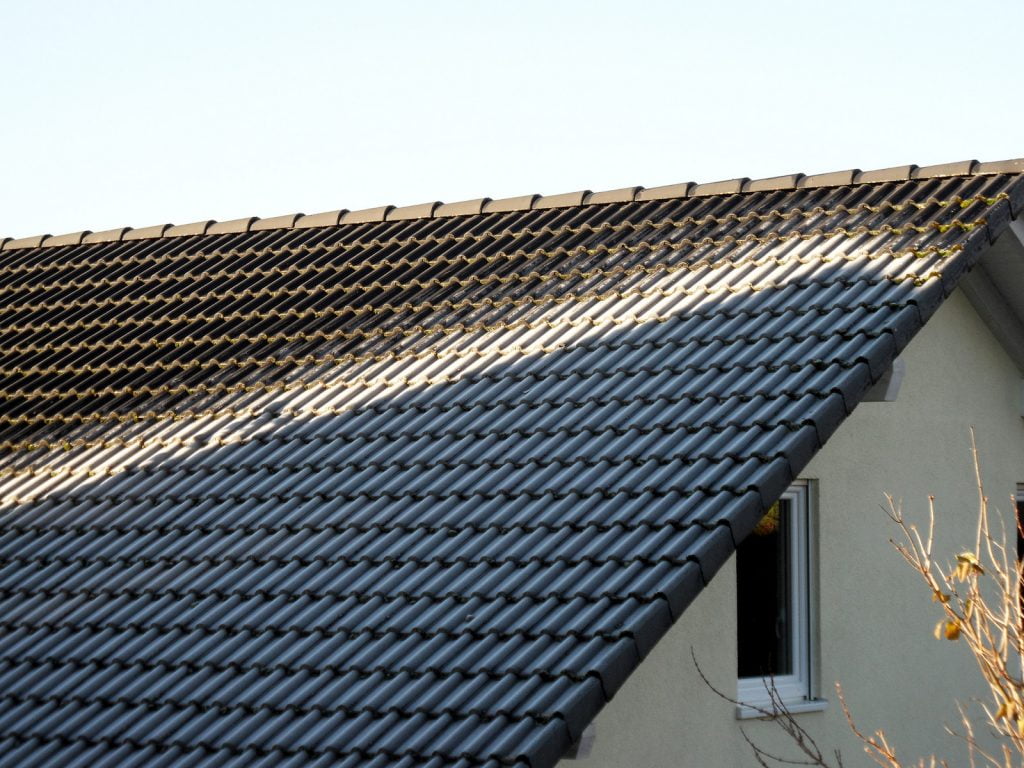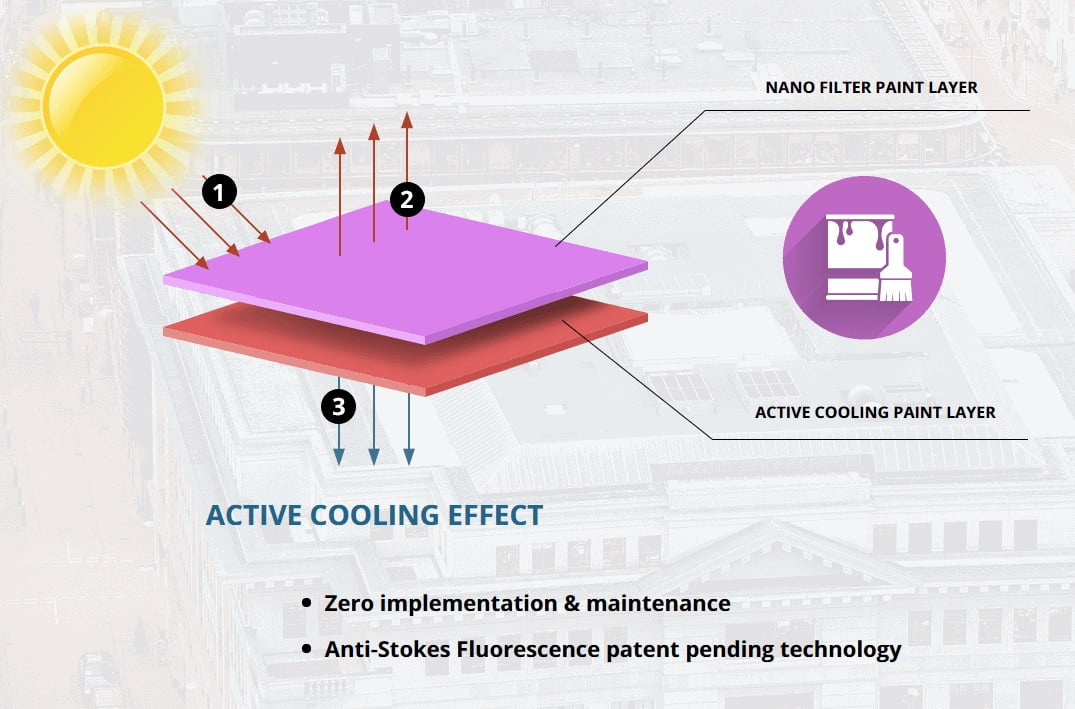Natural sunlight could soon become a new, counter-intuitive, but innovative air-conditioner. Three Israeli entrepreneurs developed a way to turn energy from the sun, a source of heat, into a cooling agent that could save billions on electricity and have significant environmental, and even security, benefits.
Yaron Shenhav and Gadi Grottas, the co-founders of SolCold, and Hebrew University Professor Guy Ron have invented a high-tech, light-filtering coating that can be applied to buildings and other surfaces which is then activated by the sun, using its strong rays to cool down structures. In fact, the more the sun shines, the cooler it gets, the Herzliya-based company says.
It’s as if there were “a thin layer of ice that gets thicker and cooler as the sun gets stronger,” Shenhav tells NoCamels.
The paint is based on a patent-pending technology SolCold developed called Anti-Stokes Fluorescence, which reverses the natural phenomenon of energy (photons) released by the sun and then absorbed by everything around it, like roads, buildings, cars, tanks, cargo and so on.
SEE ALSO: World Environment Day 2017: Israeli Solar Energy Tree ‘Planted’ In Central France
With Anti-Stokes Fluorescence, “the material being hit by a photon emits back a higher frequency photon, losing its own energy and cooling down,” Shenhav and Grottas explain to NoCamels. “Heat from a building could be absorbed and re-emitted as light,” Shenhav says. “As long as the sun is shining on it, it would be continuously cooled.”
The paint developed by SolCold consists of two layers: the outer one that filters out the sun’s rays and the inner one that actively cools the material by turning heat into light.
The technology was successfully tested in a lab, says Shenhav, and the applied paint “cooled down an object by 1.2 degrees Celsius (34.6 Fahrenheit) using just 1 percent of the sun’s energy with a sun simulator.”
At the current stage of development, the paint comes in a single color — light blue — with plans to offer the material in a variety of shades.
It’s also not cheap, costing an estimated $2 per one square meter (0.0002 acres), or $200 to coat 100 square meters (0.02 acres). For cost-efficiency, applying it to the roof of a given building is likely the best way, but all exterior walls are applicable as well, as long as they have exposure to the sun, the company says.
Environmental benefits
The benefits are said to be significant.
In hot weather, electricity grids become strained as people blast their air conditioning day and night. In Israel, the national electric company issues a number of warnings every summer — when temperatures can soar over 40 degrees Celsius (104 Fahrenheit) — to use air-conditioners more sparingly, lest the grids shut down. Electricity bills too skyrocket.
Shenhav says he was precisely in the situation — sitting in a sweltering Tel Aviv apartment during the summer with a barely functioning A/C — when he came up with the original idea (which involved optic cables and was later abandoned in favor of developing a method to harness the sun’s radiation for cooling.)
Use of the paint by SolCold can help decrease electricity consumption by up to 60 percent, and “if it’s a new building some air-conditioning systems can be eliminated.”
Sign up for our free weekly newsletter
Subscribe“Now imagine what would happen if all the buildings in Tel Aviv, for example, have this coating on the roof. The entire city would consume 60 percent less energy in the hottest days of summer, and when that happens, our power plants would need to produce 60 percent less electricity – meaning much less CO2 (carbon dioxide) would be released into the air by the power plants,” Shenhav tells NoCamels.
Another environmental benefit, he says, is that the paint is “100 percent green technology and free of carbon emission as we do not consume electricity, or any other man-made energy sources.”
But what happens in winter when we need more heat? Shenhav explains that when it’s winter season, “the cooling effect would be reduced by 50 percent due to more rainy days when clouds hide the sun.”
But the cooling will still take place, which is why SolCold says it is targeting its product toward warmer climates such as “the sun belt in the US, Central and South America, southern Europe, the Middle East, [some parts of China] and Oceania.”
Beyond buildings
SolCold — Sol as in Latin for sun and when combined with “cold” sounds like “so cold!” Shehav says with a smile — was selected in 2016 as one of six Israeli companies by the White House to take part in that year’s Global Entrepreneurship Summit at Stanford University, and was a finalist last month at the deep tech competition Hello Tomorrow in Paris.
Though it didn’t snatch the prize, Shenhav says their presentation generated a buzz and they have begun speaking to potential investors for a Series A funding round they expect to complete by 2018. Shenhav tells NoCamels the interest is a marked difference from when SolCold was looking for initial investment and “people just couldn’t grasp the idea.” They eventually landed an angel investor and emerged from “stealth mode” in July, after completing scientific lab work to show proof of concept.
The funds will serve to help SolCold develop the material on a large scale and begin testing on three selected buildings — two commercial and one residential — in Israel and Cyprus. The company believes early adopters will be large commercial structures like factories, shopping malls and stadiums.
SEE ALSO: Aiming High: Israeli Architects Build Eco-Home From Cannabis On Mount Carmel
SolCold also has its sights on cargo, automotive, space and military markets, estimated at a total of almost $100 billion.
“As a principle, our technology can cool anything under the sun,” Shenhav says, but indicates that satellite and space applications especially “are a big market for us.”
“In space there is a big problem to cool down equipment since there is no air to ‘conduct’ the heat,” he explains, “so they use expensive internal systems to isolate and ventilate. Therefore in space applications, there is a big need for a cooling coating like ours that emits the heat via radiation.”
The same cooling principle applies to military equipment, says Shenhav, with an added advantage: as the paint cools the equipment, in theory it can also serve as a camouflage against infrared detection.
Top image source: Via Onnola on Flickr
Related posts

Editors’ & Readers’ Choice: 10 Favorite NoCamels Articles

Forward Facing: What Does The Future Hold For Israeli High-Tech?

Impact Innovation: Israeli Startups That Could Shape Our Future






Facebook comments